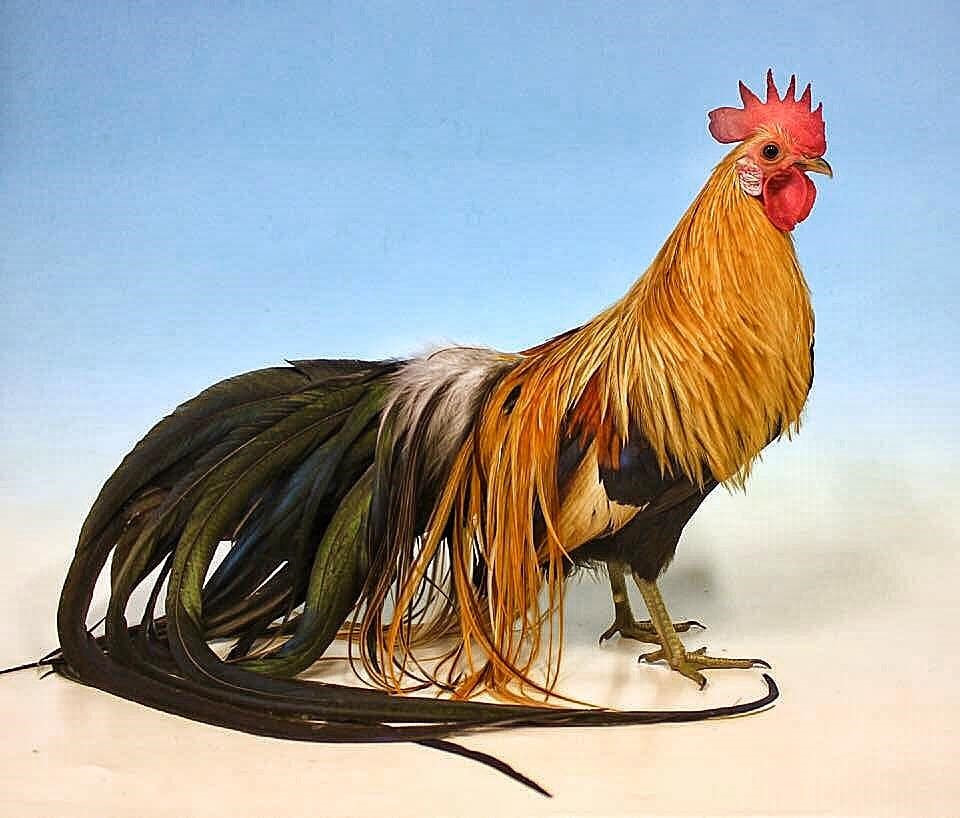The earliest recorded long-tailed fowls were found in China and sent home by Japanese diplomatic representatives. This was sometime between 600 and 800AD in our calendar. Not all accounts agree about dates and details of events so long ago. The original type birds were called Shokoku in Japan, and from them were developed several other Japanese long-tailed breeds, which are summarized at the end of this Standard. Several of these Japanese long-tailed breeds were exported to Europe, the first recorded by M.Girard, a French missionary, in 1864. These and later shipments were consigned from the port of Yokohama, which became the name by which all long-tailed fowl were called by Europeans who were not able, or did not bother, to discover the true breed names and details from Japanese experts. A leading German fancier, Hugo du Roi, bred and promoted the red lobed and somewhat gamey, Red Saddled White Yokohama (circa 1880), but it is not clear if he made them himself by crossing various imports or actually imported birds of this colour and type. This variety is unknown in Japan now, but might have existed then. In an effort to bring some order to their assortment of imported types, German fanciers restricted the name Yokohama to the Red Saddled Whites, and invented a new name, Phoenix, for the white lobed, single combed type. British fanciers formed a Yokohama Club about 1904 and decided to use that name for all types; which is why we now have one very long and complex standard for what really should be several breeds. Yokohama Bantams were made by various German fanciers by crossing large Yokohamas with assorted bantams of appropriate colours.
General characteristics: male
Type: Body fairly long and deep, full round breast, long back tapering to tail, long wings carried rather low but close to the body. Tail as long and flowing as possible, with a great abundance of side hangers - the whole tail carried low and forming a graceful curve. Saddle hackles extremely abundant, long and narrow and covering the wing tips. The saddle hackles are long enough to drag on the ground on good old cocks. Carriage is stylish and pheasant-like.
Head: Skull small, slightly long and tapering. Beak strong and curved. Eyes bright. Comb single, pea or walnut (single comb not permitted on Red Saddled variety). Single comb: small and upright. Pea comb: small, neat and straight. Walnut: medium sized. Face of fine texture. Earlobes small, oval, closely fitting. Wattles are medium sized and rounded (small or absent on Red Saddled variety).
Neck: Long and furnished with flowing hackle, which should completely encircle the neck.
Legs and feet: Legs of medium length (longer legs allowed on Red Saddled variety), the shanks fine and free of feather. Four toes, well spread.
Female
The back long, tapering to the tail and furnished with long tail covert feathers. Tail very long and carried horizontally with the two top feathers gracefully curved, and the side coverts sickle- like. The remaining general characteristics are similar to those of the male, allowing for natural sexual differences.
BANTAM
The same standard as in large fowl applies to bantams.
General characteristics: male
Type: Body fairly long and deep, full round breast, long back tapering to tail, long wings carried rather low but close to the body. Tail as long and flowing as possible, with a great abundance of side hangers - the whole tail carried low and forming a graceful curve. Saddle hackles extremely abundant, long and narrow and covering the wing tips. The saddle hackles are long enough to drag on the ground on good old cocks. Carriage is stylish and pheasant-like.
Head: Skull small, slightly long and tapering. Beak strong and curved. Eyes bright. Comb single, pea or walnut (single comb not permitted on Red Saddled variety). Single comb: small and upright. Pea comb: small, neat and straight. Walnut: medium sized. Face of fine texture. Earlobes small, oval, closely fitting. Wattles are medium sized and rounded (small or absent on Red Saddled variety).
Neck: Long and furnished with flowing hackle, which should completely encircle the neck.
Legs and feet: Legs of medium length (longer legs allowed on Red Saddled variety), the shanks fine and free of feather. Four toes, well spread.
Female
The back long, tapering to the tail and furnished with long tail covert feathers. Tail very long and carried horizontally with the two top feathers gracefully curved, and the side coverts sickle- like. The remaining general characteristics are similar to those of the male, allowing for natural sexual differences.
BANTAM
The same standard as in large fowl applies to bantams.
Please contact the breed registrar for more information - [email protected]


